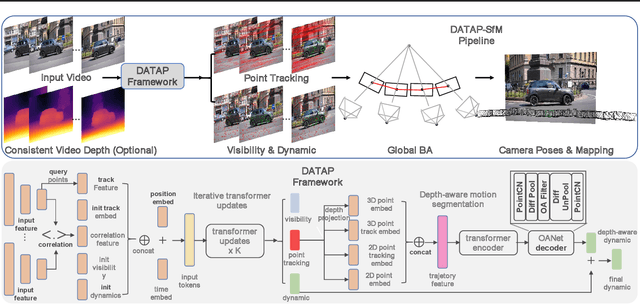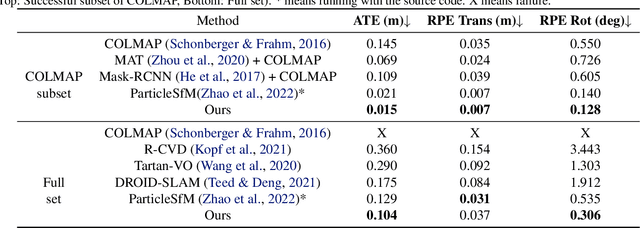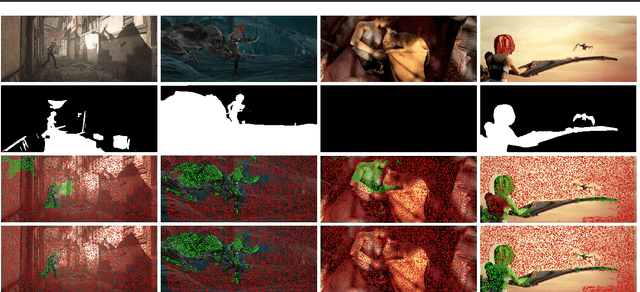Xinyu Chen
Self-Supervised Continuous Colormap Recovery from a 2D Scalar Field Visualization without a Legend
Jul 28, 2025Abstract:Recovering a continuous colormap from a single 2D scalar field visualization can be quite challenging, especially in the absence of a corresponding color legend. In this paper, we propose a novel colormap recovery approach that extracts the colormap from a color-encoded 2D scalar field visualization by simultaneously predicting the colormap and underlying data using a decoupling-and-reconstruction strategy. Our approach first separates the input visualization into colormap and data using a decoupling module, then reconstructs the visualization with a differentiable color-mapping module. To guide this process, we design a reconstruction loss between the input and reconstructed visualizations, which serves both as a constraint to ensure strong correlation between colormap and data during training, and as a self-supervised optimizer for fine-tuning the predicted colormap of unseen visualizations during inferencing. To ensure smoothness and correct color ordering in the extracted colormap, we introduce a compact colormap representation using cubic B-spline curves and an associated color order loss. We evaluate our method quantitatively and qualitatively on a synthetic dataset and a collection of real-world visualizations from the VIS30K dataset. Additionally, we demonstrate its utility in two prototype applications -- colormap adjustment and colormap transfer -- and explore its generalization to visualizations with color legends and ones encoded using discrete color palettes.
AnTKV: Anchor Token-Aware Sub-Bit Vector Quantization for KV Cache in Large Language Models
Jun 24, 2025Abstract:Quantization has emerged as an effective and lightweight solution to reduce the memory footprint of the KV cache in Large Language Models (LLMs). Nevertheless, minimizing the performance degradation caused by ultra-low-bit KV cache quantization remains a significant challenge. We observe that quantizing the KV cache of different tokens has varying impacts on the quality of attention outputs. To systematically investigate this phenomenon, we perform forward error propagation analysis on attention and propose the Anchor Score (AnS) that quantifies the sensitivity of each token's KV cache to quantization-induced error. Our analysis reveals significant disparities in AnS across tokens, suggesting that preserving a small subset with full precision (FP16) of high-AnS tokens can greatly mitigate accuracy loss in aggressive quantization scenarios. Based on this insight, we introduce AnTKV, a novel framework that leverages Anchor Token-aware Vector Quantization to compress the KV cache. Furthermore, to support efficient deployment, we design and develop a triton kernel that is fully compatible with FlashAttention, enabling fast online Anchor Token selection. AnTKV enables LLaMA-3-8B to handle context lengths up to 840K tokens on a single 80GB A100 GPU, while achieving up to 3.5x higher decoding throughput compared to the FP16 baseline. Our experiment results demonstrate that AnTKV matches or outperforms prior works such as KIVI, SKVQ, KVQuant, and CQ under 4-bit settings. More importantly, AnTKV achieves significantly lower perplexity under ultra-low-bit quantization on Mistral-7B, with only 6.32 at 1-bit and 8.87 at 0.375-bit, compared to the FP16 baseline of 4.73.
AniMaker: Automated Multi-Agent Animated Storytelling with MCTS-Driven Clip Generation
Jun 12, 2025Abstract:Despite rapid advancements in video generation models, generating coherent storytelling videos that span multiple scenes and characters remains challenging. Current methods often rigidly convert pre-generated keyframes into fixed-length clips, resulting in disjointed narratives and pacing issues. Furthermore, the inherent instability of video generation models means that even a single low-quality clip can significantly degrade the entire output animation's logical coherence and visual continuity. To overcome these obstacles, we introduce AniMaker, a multi-agent framework enabling efficient multi-candidate clip generation and storytelling-aware clip selection, thus creating globally consistent and story-coherent animation solely from text input. The framework is structured around specialized agents, including the Director Agent for storyboard generation, the Photography Agent for video clip generation, the Reviewer Agent for evaluation, and the Post-Production Agent for editing and voiceover. Central to AniMaker's approach are two key technical components: MCTS-Gen in Photography Agent, an efficient Monte Carlo Tree Search (MCTS)-inspired strategy that intelligently navigates the candidate space to generate high-potential clips while optimizing resource usage; and AniEval in Reviewer Agent, the first framework specifically designed for multi-shot animation evaluation, which assesses critical aspects such as story-level consistency, action completion, and animation-specific features by considering each clip in the context of its preceding and succeeding clips. Experiments demonstrate that AniMaker achieves superior quality as measured by popular metrics including VBench and our proposed AniEval framework, while significantly improving the efficiency of multi-candidate generation, pushing AI-generated storytelling animation closer to production standards.
SIV-Bench: A Video Benchmark for Social Interaction Understanding and Reasoning
Jun 05, 2025Abstract:The rich and multifaceted nature of human social interaction, encompassing multimodal cues, unobservable relations and mental states, and dynamical behavior, presents a formidable challenge for artificial intelligence. To advance research in this area, we introduce SIV-Bench, a novel video benchmark for rigorously evaluating the capabilities of Multimodal Large Language Models (MLLMs) across Social Scene Understanding (SSU), Social State Reasoning (SSR), and Social Dynamics Prediction (SDP). SIV-Bench features 2,792 video clips and 8,792 meticulously generated question-answer pairs derived from a human-LLM collaborative pipeline. It is originally collected from TikTok and YouTube, covering a wide range of video genres, presentation styles, and linguistic and cultural backgrounds. It also includes a dedicated setup for analyzing the impact of different textual cues-original on-screen text, added dialogue, or no text. Our comprehensive experiments on leading MLLMs reveal that while models adeptly handle SSU, they significantly struggle with SSR and SDP, where Relation Inference (RI) is an acute bottleneck, as further examined in our analysis. Our study also confirms the critical role of transcribed dialogue in aiding comprehension of complex social interactions. By systematically identifying current MLLMs' strengths and limitations, SIV-Bench offers crucial insights to steer the development of more socially intelligent AI. The dataset and code are available at https://kfq20.github.io/sivbench/.
VerIPO: Cultivating Long Reasoning in Video-LLMs via Verifier-Gudied Iterative Policy Optimization
May 25, 2025Abstract:Applying Reinforcement Learning (RL) to Video Large Language Models (Video-LLMs) shows significant promise for complex video reasoning. However, popular Reinforcement Fine-Tuning (RFT) methods, such as outcome-based Group Relative Policy Optimization (GRPO), are limited by data preparation bottlenecks (e.g., noise or high cost) and exhibit unstable improvements in the quality of long chain-of-thoughts (CoTs) and downstream performance.To address these limitations, we propose VerIPO, a Verifier-guided Iterative Policy Optimization method designed to gradually improve video LLMs' capacity for generating deep, long-term reasoning chains. The core component is Rollout-Aware Verifier, positioned between the GRPO and Direct Preference Optimization (DPO) training phases to form the GRPO-Verifier-DPO training loop. This verifier leverages small LLMs as a judge to assess the reasoning logic of rollouts, enabling the construction of high-quality contrastive data, including reflective and contextually consistent CoTs. These curated preference samples drive the efficient DPO stage (7x faster than GRPO), leading to marked improvements in reasoning chain quality, especially in terms of length and contextual consistency. This training loop benefits from GRPO's expansive search and DPO's targeted optimization. Experimental results demonstrate: 1) Significantly faster and more effective optimization compared to standard GRPO variants, yielding superior performance; 2) Our trained models exceed the direct inference of large-scale instruction-tuned Video-LLMs, producing long and contextually consistent CoTs on diverse video reasoning tasks; and 3) Our model with one iteration outperforms powerful LMMs (e.g., Kimi-VL) and long reasoning models (e.g., Video-R1), highlighting its effectiveness and stability.
From Air to Wear: Personalized 3D Digital Fashion with AR/VR Immersive 3D Sketching
May 15, 2025Abstract:In the era of immersive consumer electronics, such as AR/VR headsets and smart devices, people increasingly seek ways to express their identity through virtual fashion. However, existing 3D garment design tools remain inaccessible to everyday users due to steep technical barriers and limited data. In this work, we introduce a 3D sketch-driven 3D garment generation framework that empowers ordinary users - even those without design experience - to create high-quality digital clothing through simple 3D sketches in AR/VR environments. By combining a conditional diffusion model, a sketch encoder trained in a shared latent space, and an adaptive curriculum learning strategy, our system interprets imprecise, free-hand input and produces realistic, personalized garments. To address the scarcity of training data, we also introduce KO3DClothes, a new dataset of paired 3D garments and user-created sketches. Extensive experiments and user studies confirm that our method significantly outperforms existing baselines in both fidelity and usability, demonstrating its promise for democratized fashion design on next-generation consumer platforms.
Perception, Reason, Think, and Plan: A Survey on Large Multimodal Reasoning Models
May 08, 2025Abstract:Reasoning lies at the heart of intelligence, shaping the ability to make decisions, draw conclusions, and generalize across domains. In artificial intelligence, as systems increasingly operate in open, uncertain, and multimodal environments, reasoning becomes essential for enabling robust and adaptive behavior. Large Multimodal Reasoning Models (LMRMs) have emerged as a promising paradigm, integrating modalities such as text, images, audio, and video to support complex reasoning capabilities and aiming to achieve comprehensive perception, precise understanding, and deep reasoning. As research advances, multimodal reasoning has rapidly evolved from modular, perception-driven pipelines to unified, language-centric frameworks that offer more coherent cross-modal understanding. While instruction tuning and reinforcement learning have improved model reasoning, significant challenges remain in omni-modal generalization, reasoning depth, and agentic behavior. To address these issues, we present a comprehensive and structured survey of multimodal reasoning research, organized around a four-stage developmental roadmap that reflects the field's shifting design philosophies and emerging capabilities. First, we review early efforts based on task-specific modules, where reasoning was implicitly embedded across stages of representation, alignment, and fusion. Next, we examine recent approaches that unify reasoning into multimodal LLMs, with advances such as Multimodal Chain-of-Thought (MCoT) and multimodal reinforcement learning enabling richer and more structured reasoning chains. Finally, drawing on empirical insights from challenging benchmarks and experimental cases of OpenAI O3 and O4-mini, we discuss the conceptual direction of native large multimodal reasoning models (N-LMRMs), which aim to support scalable, agentic, and adaptive reasoning and planning in complex, real-world environments.
VideoVista-CulturalLingo: 360$^\circ$ Horizons-Bridging Cultures, Languages, and Domains in Video Comprehension
Apr 23, 2025Abstract:Assessing the video comprehension capabilities of multimodal AI systems can effectively measure their understanding and reasoning abilities. Most video evaluation benchmarks are limited to a single language, typically English, and predominantly feature videos rooted in Western cultural contexts. In this paper, we present VideoVista-CulturalLingo, the first video evaluation benchmark designed to bridge cultural, linguistic, and domain divide in video comprehension. Our work differs from existing benchmarks in the following ways: 1) Cultural diversity, incorporating cultures from China, North America, and Europe; 2) Multi-linguistics, with questions presented in Chinese and English-two of the most widely spoken languages; and 3) Broad domain, featuring videos sourced from hundreds of human-created domains. VideoVista-CulturalLingo contains 1,389 videos and 3,134 QA pairs, and we have evaluated 24 recent open-source or proprietary video large models. From the experiment results, we observe that: 1) Existing models perform worse on Chinese-centric questions than Western-centric ones, particularly those related to Chinese history; 2) Current open-source models still exhibit limitations in temporal understanding, especially in the Event Localization task, achieving a maximum score of only 45.2%; 3) Mainstream models demonstrate strong performance in general scientific questions, while open-source models demonstrate weak performance in mathematics.
CoProSketch: Controllable and Progressive Sketch Generation with Diffusion Model
Apr 11, 2025Abstract:Sketches serve as fundamental blueprints in artistic creation because sketch editing is easier and more intuitive than pixel-level RGB image editing for painting artists, yet sketch generation remains unexplored despite advancements in generative models. We propose a novel framework CoProSketch, providing prominent controllability and details for sketch generation with diffusion models. A straightforward method is fine-tuning a pretrained image generation diffusion model with binarized sketch images. However, we find that the diffusion models fail to generate clear binary images, which makes the produced sketches chaotic. We thus propose to represent the sketches by unsigned distance field (UDF), which is continuous and can be easily decoded to sketches through a lightweight network. With CoProSketch, users generate a rough sketch from a bounding box and a text prompt. The rough sketch can be manually edited and fed back into the model for iterative refinement and will be decoded to a detailed sketch as the final result. Additionally, we curate the first large-scale text-sketch paired dataset as the training data. Experiments demonstrate superior semantic consistency and controllability over baselines, offering a practical solution for integrating user feedback into generative workflows.
DATAP-SfM: Dynamic-Aware Tracking Any Point for Robust Structure from Motion in the Wild
Nov 20, 2024



Abstract:This paper proposes a concise, elegant, and robust pipeline to estimate smooth camera trajectories and obtain dense point clouds for casual videos in the wild. Traditional frameworks, such as ParticleSfM~\cite{zhao2022particlesfm}, address this problem by sequentially computing the optical flow between adjacent frames to obtain point trajectories. They then remove dynamic trajectories through motion segmentation and perform global bundle adjustment. However, the process of estimating optical flow between two adjacent frames and chaining the matches can introduce cumulative errors. Additionally, motion segmentation combined with single-view depth estimation often faces challenges related to scale ambiguity. To tackle these challenges, we propose a dynamic-aware tracking any point (DATAP) method that leverages consistent video depth and point tracking. Specifically, our DATAP addresses these issues by estimating dense point tracking across the video sequence and predicting the visibility and dynamics of each point. By incorporating the consistent video depth prior, the performance of motion segmentation is enhanced. With the integration of DATAP, it becomes possible to estimate and optimize all camera poses simultaneously by performing global bundle adjustments for point tracking classified as static and visible, rather than relying on incremental camera registration. Extensive experiments on dynamic sequences, e.g., Sintel and TUM RGBD dynamic sequences, and on the wild video, e.g., DAVIS, demonstrate that the proposed method achieves state-of-the-art performance in terms of camera pose estimation even in complex dynamic challenge scenes.
 Add to Chrome
Add to Chrome Add to Firefox
Add to Firefox Add to Edge
Add to Edge